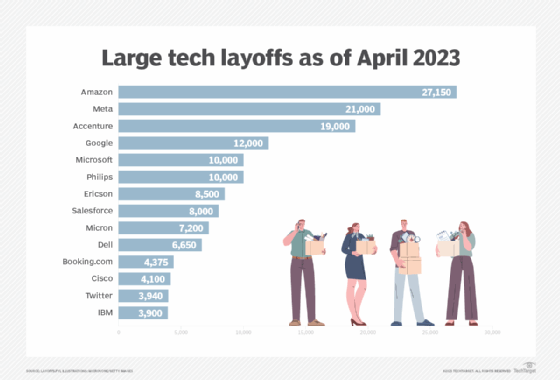
Getty Images
Tech sector layoffs explained: What you need to know
Large tech layoffs continue through 2024 with headlines showing thousands of people losing their jobs. Here is why the economy, interest rates and pandemic hiring are to blame.
Layoffs are making headlines, and most seem to be centered on one job sector: tech.
In August 2024, Intel announced plans to reduce its workforce by 15% -- roughly 15,000 jobs -- saying the majority of these cuts would be made by the end of the year. This is part of an effort to reduce costs by $10 billion in 2025.
In July 2024, Massachusetts-based software company UKG made headlines when it laid off 14% of its workforce in North America -- eliminating about 2,200 jobs of an estimated 15,000 employees worldwide.
As of October 2024, 476 tech companies have laid off more than 141,467 employees in 2024, according to Layoffs.fyi. In 2022 and 2023 combined, 428,449 people working for tech companies were laid off.
The overall labor sector appeared strong in 2022 and into 2023, but the tech sector layoffs tend to be the most visible. Because the tech giants have many employees, a small percentage of layoffs still translates to thousands of people losing their jobs. Even after the dot-com bubble, the tech industry has been resilient to economic challenges due to its size and growing presence for personal and business use. Most of these large layoffs are from big household-name companies.
There are several factors contributing to tech layoffs, including the economy, inflation, higher interest rates, overhiring and COVID-19 pandemic job correction.
Artificial intelligence (AI)
AI is splitting the tech job market as companies look to hire employees with AI-related skills. Around 10% of U.S. jobs face a risk from AI disruption, according to the Economic Report of the President.
This disruption does not mean job loss but could complement some of these workers and increase productivity. The biggest fear of job loss due to AI is for those who do not learn to use AI.
However, IBM fueled the AI-job-takeover fire, when the company told employees in a meeting that it plans to cut 3,900 jobs in the marketing and communications division -- or 1.5% of its workforce. The company also planned to stop hiring for roles that could be replaced by AI, according to Bloomberg.
Check out some of the jobs that may be affected by AI.
Economic downturn
Debates of a U.S. recession started when data from the U.S. Bureau of Economic Analysis showed a shrinking economy in July 2022 for the second straight quarter. Economists are unsure, and the fear of a recession still looms in news reports. Other conditions threaten the economy's health, such as the government debt ceiling, the war in Ukraine, the ongoing pandemic and the rise in interest rates.
Companies turn to layoffs as a survival method to cut costs when revenue and profits get leaner.
Inflation
When inflation hit the economy hard in June 2022, consumers saw price increases of 9.1% compared to the typical annual rate of 2% for steady inflation, according to the Federal Reserve. 2022 saw the highest inflation rate in 40 years, according to the U.S. Bureau of Labor Statistics (BLS). The economy softened as people started buying less to accommodate these higher prices. The cost of living jumped significantly, and people and businesses had to make cutbacks. Technology companies saw price increases for services, so companies had to evaluate and make cuts if necessary.
Businesses look to cut costs to cover their increased expenses due to inflation. Laying off employees is typically one of the first cost-cutting measures because they are one of the largest company expenses. Tech companies lose revenue when businesses cut back advertising. Tech companies, such as Meta, Google, Instagram, Snap and ByteDance, have business models that rely on selling ads.

Higher interest rates
The Federal Reserve raised the interest rates seven times in 2022 and may raise them more in 2023. The Fed raises these rates to slow economic growth and deter both consumers and businesses from spending, which reduces demand to ultimately lower prices.
Higher interest rates affect how much a company wants to borrow due to higher costs. These higher rates directly impact venture capitalists (VCs) and other funding of startups. Companies do not want to invest in riskier areas when the economy's future is uncertain. Economic uncertainties cause companies to reevaluate their hiring and growth strategies.
The Fed has not changed the interest rates as of March 2024.
Investor pressure
Investors want companies to decrease expenses as revenues slow down. VCs are worried that profits will be down this year after the large growth period. For example, TCI Fund Management called on Alphabet, Google's parent company, to reduce head count and take action for improved profitability. Other big tech companies, such as Meta and Microsoft, also faced backlash from investors, saying their head count was too high compared to other companies.
Overhiring during the pandemic
Part of the rise in layoffs is due to correcting the hiring of too many people. During the height of the pandemic, the use of technology grew significantly as everything moved online. People were working remotely, shopping online, ordering groceries to be picked up or delivered, streaming movies at home and taking classes online instead of in person. Many were under quarantine and encouraged to stay home, so people spent more time online.
The surge in online activity brought tech companies record-level profits and started a hiring frenzy to keep up with the demand. Tech companies thought this would be the new normal, expanding their teams and growing quickly.
Meta nearly doubled its employee head count. In March 2020, Meta reported 48,268 staffers and more than 80,000 by September 2022. In November 2022, the company announced it was laying off 11,000 employees.
Now, some work is shifting back to the ways before the pandemic. If people are doing hybrid work schedules, people aren't using tech as much as they were when working from home full time. Instead, they are spending time going into stores, traveling, attending sporting events, going to concerts and dining at restaurants. With the lower demand for tech services, the need for these new hires also decreased.
Post-pandemic reality
Many workers hired during the pandemic were not entry-level employees, but experienced software engineers and developers earning salaries in the six figures with generous benefits. Companies are facing too many employees with redundancy and overstaffing. Companies had high hopes to continue this rate of growth. However, as restrictions lifted, people returned to pre-pandemic lifestyles. With the return to previous work environments, big tech companies are removing the extra layer of employees hired during the height of the pandemic.
Technology for working from home, such as Google Meet, Microsoft Teams and Zoom, are still being used but with lowered numbers since every meeting is no longer only online. Several workers are returning to the office for collaboration and sharing ideas.
Mature industry
The tech layoffs may also be a result of the industry maturing or becoming more stable after rapid growth. Tech companies may not be on pace to acquire as many new customers since many people have already adopted their services. Instead, tech companies may be looking beyond growth and into diversifying products or expanding globally.
Silicon Valley Bank collapse
In March 2023, the tech industry faced another obstacle as the Silicon Valley Bank (SVB) collapsed due to lack of diversification and a bank run. SVB funded tech startup companies when other banks were unwilling to take on the higher risks.
With the collapse of SVB, more venture capitalists and banks are going to be nervous about taking on the risk of start-up companies.
Notable layoffs
Depending on the size of the company, large layoffs may be in the tens of thousands or a few hundred, which can be a large percentage of its workforce. Some companies -- such as Meta -- have announced large layoffs in a couple of waves. Meta cut 11,000 employees in November 2022, then cut an additional 10,000 people in March 2023. Amazon also had multiple large cuts, including 10,000 employees in November 2022, 8,000 in January 2023 and 9,000 in March 2023.
Virgin Orbit cut 85% of its workforce, which equals around 675 staff members. Virgin Orbit launches services for satellites and operates within Virgin Group. Even though the numbers are not as high as big tech, it is still a large portion of its workforce.
Accenture is also cutting 2.5% of its workforce in 2023, which is an estimated 19,000 employees.
Elon Musk said in a BBC interview that he has reduced Twitter staff by about 80%, cutting more than 6,000 employees since taking over. Twitter had approximately 8,000 employees when Musk took over and now has around 1,500 employees after layoffs.
As of March 2024, layoffs are still happening. Some of the most notable include 8,000 employees laid off from SAP, 4,250 from Cisco, 2,500 from PayPal, 1,500 from Expedia and 1,000 from eBay.
Will layoffs spread into other industries?
The U.S. tech industry accounts for about 8.9 million people in the total workforce, according to CompTIA 's "State of the Tech Workforce" report. Even though there have been several layoffs in the tech and media industries, other labor markets have been steady.
The U.S. unemployment rate fell in December 2022 from 3.7% to 3.5%. This is a 50-year low, according to BLS. As of February 2024, the national unemployment rate increased to 3.9%.
Large tech companies make the news with large cuts, but some smaller and midsize companies are still hiring tech workers, according to BLS.







